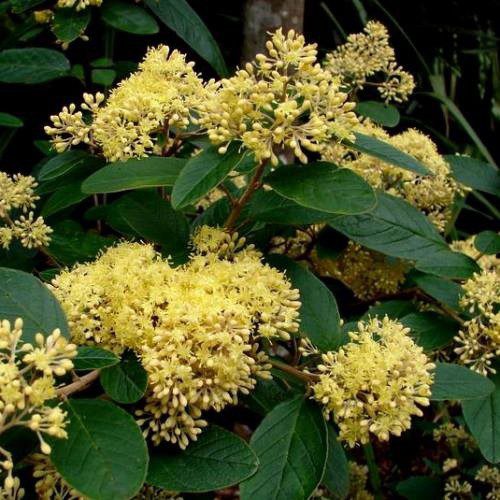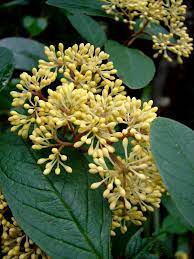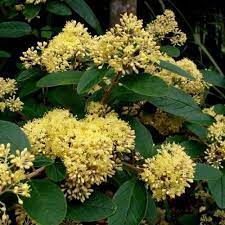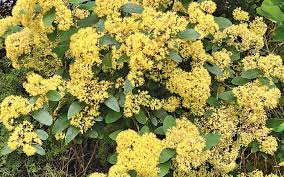Pomaderris kumeraho, commonly known as Kumerahou, is a flowering shrub native to New Zealand. Belonging to the family Rhamnaceae, this plant is renowned for its distinctive yellow flowers and its historical and cultural significance to the indigenous Māori people.
Kumerahou is an evergreen shrub characterized by its dense clusters of small, oval-shaped leaves that are coated with a unique layer of soft, white hairs, giving the foliage a silvery appearance. During the spring months, Kumerahou produces clusters of bright yellow flowers that emerge from the leaf axils, creating a striking display of color against the foliage.
In addition to its ornamental value, Kumerahou holds significant cultural importance to the Māori people, who have traditionally used various parts of the plant for medicinal purposes. The leaves and bark contain saponins, natural compounds with soap-like properties, which were used by the Māori for making soap and shampoo.
The name “Kumerahou” itself is derived from the Māori words “kume,” meaning foam or lather, and “rahou,” meaning soft or pliable, referencing the plant’s traditional use in producing cleansing lathers.
Furthermore, Kumerahou has been utilized in traditional Māori medicine for its purported healing properties. The plant was used as a treatment for various ailments, including coughs, colds, and respiratory infections. The leaves and bark were brewed into a tea or infusion and ingested, or the lather produced from the plant was applied topically to the skin.
In contemporary times, Kumerahou continues to be valued for its ornamental beauty and cultural significance. It is cultivated in gardens and landscaping projects throughout New Zealand, where it serves as a reminder of the rich botanical heritage and traditional knowledge of the Māori people.
Overall, Pomaderris kumeraho, or Kumerahou, is a cherished plant that not only enhances the natural beauty of New Zealand’s landscapes but also honors the cultural traditions and healing practices of the indigenous Māori people.
The Botanical Description of Pomaderris kumeraho
1. Growth Habit: Pomaderris kumeraho, commonly known as kumerahou, is a shrub characterized by its upright growth habit. It typically reaches heights of 1 to 3 meters and features a dense, bushy appearance.
2. Leaves: The leaves of Pomaderris kumeraho are thick, leathery, and elliptical in shape. They have a glossy green surface and are arranged alternately along the stems. The margins may be slightly toothed.
3. Flowers: Kumerahou produces small, yellow flowers arranged in clusters, creating a visually striking display. The blooms are often seen in abundance during the flowering season, attracting pollinators such as bees.
4. Bark: The bark of Pomaderris kumeraho is smooth and grayish-brown in color. It provides protection to the underlying stems and branches while contributing to the overall aesthetics of the shrub.
5. Fruits: The fruits of kumerahou are small capsules that contain seeds. These capsules are often inconspicuous compared to the vibrant flowers but play a crucial role in the plant’s reproductive cycle.
6. Root System: Pomaderris kumeraho develops a fibrous root system, aiding in nutrient absorption and anchoring the shrub in various soil types.
7. Seasonal Changes: Throughout the seasons, kumerahou undergoes changes in appearance. In spring, the shrub bursts into a profusion of yellow blossoms, while in autumn, the leaves may display hues of red and brown before falling.
8. Aroma: Kumerahou is not particularly known for a distinctive aroma, with its visual appeal taking precedence over olfactory characteristics.
9. Adaptability: This shrub is adaptable to different environmental conditions and can thrive in a variety of soil types, including sandy and loamy soils.
10. Growth Rate: Pomaderris kumeraho has a moderate growth rate, allowing it to establish itself in landscapes without becoming overly invasive.
11. Conservation Status: While not endangered, conservation efforts may focus on preserving the natural habitats where kumerahou flourishes.
12. Cultural Significance: In addition to its botanical features, kumerahou holds cultural significance among certain indigenous communities, playing a role in traditional practices and herbal remedies.
The Geographic Distribution of Pomaderris kumeraho

1. Native Range: Pomaderris kumeraho is native to New Zealand, where it is found in both the North and South Islands. It thrives in the country’s diverse ecosystems, including forests, coastal areas, and scrublands.
2. Habitat Preferences: This shrub demonstrates adaptability to various habitats, ranging from lowland forests to higher-altitude areas. It can often be spotted along forest margins and in disturbed areas.
3. Global Distribution: While primarily found in New Zealand, efforts may be underway to introduce Pomaderris kumeraho to other regions with suitable climates and conditions. However, caution is exercised to prevent potential invasiveness.
4. Altitude Range: Kumerahou exhibits a wide altitude range, growing from sea level to higher elevations. This adaptability contributes to its prevalence in different ecosystems.
5. Environmental Factors: The distribution of Pomaderris kumeraho is influenced by environmental factors such as soil composition, rainfall patterns, and exposure to sunlight. It thrives in areas with well-drained soils and receives a moderate amount of rainfall.
6. Conservation Considerations: Conservation efforts may involve protecting the natural habitats of Pomaderris kumeraho and addressing any potential threats to its survival, including habitat loss.
7. Ecological Interactions: Kumerahou contributes to local ecosystems by providing habitat and food for various fauna, including pollinators attracted to its flowers.
8. Human Impact: Human activities, such as land development and deforestation, can impact the geographic distribution of Pomaderris kumeraho. Conservation initiatives may aim to mitigate these impacts.
9. Protected Areas: Some regions may designate protected areas or reserves to conserve the natural habitats where Pomaderris kumeraho is prevalent. These areas play a crucial role in maintaining biodiversity.
10. Cultural Significance: The geographic distribution of kumerahou is intertwined with its cultural significance in the traditions and practices of indigenous communities in New Zealand.
The Chemical Composition of Pomaderris kumeraho
1. Flavonoids: Pomaderris kumeraho contains flavonoids, which are plant compounds with antioxidant properties. These compounds contribute to the plant’s ability to combat oxidative stress.
2. Triterpenoids: Triterpenoids are present in kumerahou and may have potential medicinal properties. Research is ongoing to explore their specific bioactive effects.
3. Alkaloids: Some alkaloids may be found in Pomaderris kumeraho, contributing to the plant’s overall chemical composition. Alkaloids often have physiological effects on living organisms.
4. Essential Oils: The presence of essential oils in kumerahou adds to its aromatic profile. These oils may have therapeutic applications.
5. Polyphenols: Polyphenolic compounds, including tannins, are part of the chemical makeup of Pomaderris kumeraho. These compounds may contribute to the plant’s interactions with its environment.
6. Saponins: Kumerahou may contain saponins, which are natural surfactants with potential health benefits. Research explores their role in traditional medicinal uses.
7. Lignans: Lignans, known for their antioxidant properties, may be present in Pomaderris kumeraho. These compounds contribute to the overall health-promoting potential of the plant.
8. Phenolic Acids: Phenolic acids are part of the chemical composition of kumerahou and are known for their antioxidant and anti-inflammatory properties.
9. Terpenes: Terpenes, including monoterpene and sesquiterpene compounds, are constituents of Pomaderris kumeraho. These compounds may have diverse biological activities.
10. Glycosides: Certain glycosides may be found in kumerahou, and their presence contributes to the plant’s chemical diversity. Glycosides are compounds formed by the combination of a sugar molecule with another moiety.
11. Proteins and Amino Acids: Pomaderris kumeraho contains proteins and amino acids, essential building blocks for various physiological processes.
12. Carbohydrates: Carbohydrates are a fundamental component of the chemical composition of kumerahou, serving as an energy source and contributing to the plant’s structure.
13. Lipids: Lipids, including fatty acids and other lipid molecules, are part of the chemical composition of Pomaderris kumeraho. These compounds play roles in energy storage and cellular structure.
14. Trace Elements: The presence of trace elements, such as minerals, adds to the nutritional profile of kumerahou. These elements contribute to the overall health of the plant.
15. Secondary Metabolites: Pomaderris kumeraho produces various secondary metabolites, including those with potential therapeutic properties. The exploration of these metabolites is an active area of research.
Read Also: Chiggers: Description, Damages Caused, Control and Preventive Measures
The Medicinal Health Benefits Of Pomaderris kumeraho (Kumerahou)

1. Respiratory Health: Pomaderris kumeraho has been traditionally used to support respiratory health. Compounds present in the plant may help alleviate symptoms of respiratory conditions, making it a valuable natural remedy.
2. Antioxidant Properties: The flavonoids and polyphenols in kumerahou contribute to its antioxidant properties. Antioxidants play a crucial role in neutralizing free radicals, protecting cells from damage.
3. Anti-Inflammatory Effects: Some constituents of Pomaderris kumeraho, including triterpenoids and phenolic acids, exhibit anti-inflammatory effects. This makes the plant a potential candidate for addressing inflammatory conditions.
4. Immune System Support: Compounds found in kumerahou may support the immune system, helping the body defend against infections and illnesses.
5. Skin Health: Kumerahou’s potential benefits extend to skin health. The plant may have soothing properties, making it suitable for addressing skin conditions and promoting overall skin wellness.
6. Traditional Healing Practices: Indigenous communities have valued Pomaderris kumeraho for its role in traditional healing practices. It is often used to create herbal preparations addressing various health concerns.
7. Respiratory Congestion Relief: Kumerahou’s expectorant properties may aid in relieving respiratory congestion, making it beneficial for individuals dealing with coughs and colds.
8. Cough Suppressant: The plant’s compounds may act as a natural cough suppressant, providing relief to individuals experiencing persistent coughing.
9. Gastrointestinal Health: Pomaderris kumeraho has been used to support gastrointestinal health, with potential benefits for digestive processes.
10. Relaxation and Stress Relief: Some individuals use kumerahou for its potential calming effects, promoting relaxation and stress relief.
11. Wound Healing: The plant’s traditional uses include promoting wound healing. Its anti-inflammatory and antimicrobial properties may contribute to this beneficial effect.
12. Potential Antimicrobial Activity: Research suggests that Pomaderris kumeraho may possess antimicrobial properties, which could be valuable in addressing infections.
13. Traditional Tonic: In certain cultures, kumerahou is considered a traditional tonic, offering overall health support when consumed regularly.
14. Adaptogenic Properties: The adaptogenic potential of Pomaderris kumeraho may help the body adapt to stressors, contributing to overall well-being.
15. Antifungal Effects: Preliminary studies indicate that kumerahou may exhibit antifungal effects, making it a potential natural remedy for fungal infections.
16. Respiratory Allergy Relief: Some individuals use Pomaderris kumeraho to alleviate symptoms associated with respiratory allergies, providing a natural option for those seeking relief.
The Methods of Usage to Achieve the Provided Health Benefits Of Pomaderris kumeraho (Kumerahou)
1. Herbal Infusions: Prepare herbal infusions by steeping dried Pomaderris kumeraho leaves in hot water. This method is commonly used to extract the plant’s beneficial compounds for respiratory and immune support.
2. Tinctures and Extracts: Tinctures and extracts are concentrated forms of kumerahou that allow for precise dosing. These can be added to beverages or taken directly for targeted health benefits.
3. Topical Applications: Create salves or creams with kumerahou extracts for topical application. This method is suitable for addressing skin conditions and promoting wound healing.
4. Steam Inhalation: Inhaling steam infused with Pomaderris kumeraho can provide respiratory relief. This method is effective for addressing congestion and soothing the respiratory tract.
5. Dietary Supplements: Some individuals choose to take Pomaderris kumeraho in the form of dietary supplements, such as capsules or tablets, to conveniently incorporate its health benefits into their routine.
6. Traditional Remedies: Explore traditional remedies passed down through indigenous knowledge. These may include specific preparations or combinations with other herbs for holistic health support.
7. Poultices: For localized benefits, create poultices by applying crushed or powdered kumerahou leaves directly to the skin. This method is useful for addressing skin conditions.
8. Herbal Teas: Enjoy Pomaderris kumeraho as a herbal tea by steeping the leaves in hot water. This simple and soothing method allows for the consumption of the plant’s health-promoting compounds.
9. Infused Oils: Create infused oils by steeping kumerahou in carrier oils. These oils can be used for massage or as a base for skincare products to harness the plant’s properties.
10. Culinary Uses: While not a common culinary herb, some may explore incorporating Pomaderris kumeraho into certain dishes for a unique infusion of its potential health benefits.
11. Smoking Blends: In some traditional practices, kumerahou may be included in smoking blends for ceremonial or therapeutic purposes. However, caution is advised due to potential health risks associated with smoking.
12. Consultation with Herbal Practitioners: Before trying various methods of usage, consider consulting with herbal practitioners or healthcare professionals to determine the most suitable approach based on individual health needs.
13. Dosage Considerations: Pay attention to recommended dosages for different methods of usage to ensure safety and efficacy. Dosages may vary based on the specific health goal and the form in which Pomaderris kumeraho is consumed.
The Side Effects Of Using Pomaderris kumeraho Medicinal Plant
1. Allergic Reactions: Some individuals may experience allergic reactions to Pomaderris kumeraho. It is advisable to perform a patch test before topical applications or consumption.
2. Gastrointestinal Discomfort: Excessive intake of kumerahou may lead to gastrointestinal discomfort, including nausea or digestive upset. Moderation is key to prevent such side effects.
3. Skin Sensitivity: Individuals with sensitive skin may experience skin irritation when using Pomaderris kumeraho topically. Dilution or discontinuation is recommended if adverse reactions occur.
4. Drug Interactions: Pomaderris kumeraho may interact with certain medications. Consultation with a healthcare professional is essential, especially for individuals taking prescription drugs.
5. Pregnancy and Breastfeeding: Pregnant and breastfeeding individuals should exercise caution when using Pomaderris kumeraho, as its safety during these periods has not been thoroughly studied.
6. Respiratory Sensitivity: Individuals with respiratory conditions or sensitivities should be cautious when using kumerahou, especially in forms like steam inhalation, to avoid potential respiratory irritation.
7. Photosensitivity: Some individuals may experience increased sensitivity to sunlight when using Pomaderris kumeraho topically. Sun protection measures are advisable during and after usage.
8. Potential Drug Potentiation: Pomaderris kumeraho may potentiate the effects of certain medications. Monitoring for any signs of potentiation and adjusting medication dosages may be necessary.
9. Children and Infants: Due to the limited research on the effects of Pomaderris kumeraho on children and infants, it is recommended to seek professional advice before use in this population.
10. Adverse Reactions in Sensitive Individuals: Sensitive individuals may experience adverse reactions to Pomaderris kumeraho, including headaches, dizziness, or skin irritation. It’s essential to start with small doses and monitor for any adverse effects before continuing use.
11. Drug Sensitivity: Individuals taking medications for pre-existing conditions should consult with a healthcare provider before incorporating Pomaderris kumeraho into their regimen, as it may interact with certain drugs and affect their efficacy.
12. Hemorrhagic Disorders: There is limited information on the effects of Pomaderris kumeraho on individuals with hemorrhagic disorders. Caution is advised, and medical supervision may be necessary for those with bleeding tendencies.
13. Liver Health: Some herbal preparations of Pomaderris kumeraho may affect liver function. Individuals with liver conditions or those taking medications that impact liver health should exercise caution and seek medical advice.
14. Hypersensitivity Reactions: Rare cases of hypersensitivity reactions to Pomaderris kumeraho have been reported. Symptoms may include itching, swelling, or difficulty breathing. Discontinue use immediately if any signs of hypersensitivity occur.
15. Long-Term Effects: Long-term use of Pomaderris kumeraho may have cumulative effects on health. It’s advisable to periodically reassess its usage and consult with healthcare professionals for guidance.
16. Overuse: Excessive consumption or application of Pomaderris kumeraho may lead to unintended consequences. It’s important to adhere to recommended dosages and usage guidelines to minimize the risk of side effects.
17. Psychological Effects: While uncommon, some individuals may experience psychological effects such as mood changes or anxiety when using Pomaderris kumeraho. Monitor mental well-being during usage and discontinue if adverse effects occur.
18. Sensitivity to Pollen: Individuals with pollen allergies may experience cross-reactivity when using Pomaderris kumeraho, particularly in regions where the plant is abundant. Consideration should be given to potential allergic responses.
19. Safety in Pets: Keep Pomaderris kumeraho and its preparations out of reach of pets, as they may react differently to herbal remedies. Consult with a veterinarian before using kumerahou products on animals.
20. Personalized Risk Assessment: Due to individual variations in health status and susceptibility, each person’s risk of experiencing side effects from Pomaderris kumeraho may differ. Conduct a personalized risk assessment before initiating usage.
21. Reporting Adverse Reactions: Any adverse reactions experienced while using Pomaderris kumeraho should be reported to healthcare professionals or regulatory agencies to contribute to ongoing safety monitoring.
Read Also: 16 Medicinal Health Benefits Of Siraitia grosvenorii (Monk Fruit)
The Scientific Research and Studies of Pomaderris kumeraho

1. Antioxidant Activity: Studies have investigated the antioxidant activity of Pomaderris kumeraho extracts, attributing this property to its flavonoid and polyphenol content. These antioxidants may help protect against oxidative stress-related diseases.
2. Anti-Inflammatory Potential: Research suggests that Pomaderris kumeraho possesses anti-inflammatory properties, which may be beneficial for conditions characterized by inflammation, such as arthritis or inflammatory bowel disease.
3. Respiratory Support: Preliminary studies have explored the respiratory benefits of Pomaderris kumeraho, indicating its potential as a natural remedy for respiratory conditions like asthma or bronchitis.
4. Immunomodulatory Effects: Some research has investigated the immunomodulatory effects of Pomaderris kumeraho, suggesting its ability to modulate immune responses and enhance immune function.
5. Wound Healing Properties: In vitro and animal studies have suggested that Pomaderris kumeraho extracts may promote wound healing by accelerating the wound closure process and enhancing tissue regeneration.
6. Antimicrobial Activity: Pomaderris kumeraho extracts have demonstrated antimicrobial activity against various pathogens, including bacteria and fungi. This antimicrobial potential may support its traditional use in addressing infections.
7. Cytotoxic Effects: Studies have explored the cytotoxic effects of Pomaderris kumeraho extracts on cancer cells, indicating its potential as an adjunctive therapy in cancer treatment.
8. Hepatoprotective Properties: Some research has investigated the hepatoprotective properties of Pomaderris kumeraho, suggesting its ability to protect the liver from damage caused by toxins or diseases.
9. Antidiabetic Effects: Preliminary studies have suggested that Pomaderris kumeraho extracts may have antidiabetic effects by modulating glucose metabolism and insulin sensitivity.
10. Neuroprotective Potential: Research indicates that Pomaderris kumeraho may have neuroprotective effects, which could be beneficial in the prevention or treatment of neurodegenerative diseases.
11. Cardiovascular Health: Studies have explored the potential cardiovascular benefits of Pomaderris kumeraho, including its effects on blood pressure regulation and cholesterol levels.
12. Gastrointestinal Protection: Pomaderris kumeraho extracts have shown potential in protecting the gastrointestinal tract from damage caused by inflammation or ulceration.
13. Antidepressant Properties: Preliminary evidence suggests that Pomaderris kumeraho may have antidepressant effects, possibly through its modulation of neurotransmitter levels in the brain.
14. Bone Health: Research has investigated the effects of Pomaderris kumeraho on bone health, indicating its potential in promoting bone formation and preventing osteoporosis.
The Safety Precautions and Recommendations In Using Pomaderris kumeraho Medicinal Plant
1. Consultation with Healthcare Professionals: Before using Pomaderris kumeraho for medicinal purposes, it is advisable to consult with healthcare professionals, especially for individuals with pre-existing health conditions or those taking medications.
2. Allergy Testing: Perform a patch test before using Pomaderris kumeraho topically to check for any allergic reactions. Discontinue use if redness, itching, or irritation occurs.
3. Dosage and Usage Guidelines: Adhere to recommended dosage and usage guidelines when using Pomaderris kumeraho to minimize the risk of adverse effects. Avoid exceeding recommended doses unless under professional supervision.
4. Pregnancy and Lactation: Pregnant and breastfeeding individuals should exercise caution when using Pomaderris kumeraho, as its safety during these periods has not been established. Consult with healthcare providers before use.
5. Monitoring for Adverse Reactions: Monitor for any signs of adverse reactions when using Pomaderris kumeraho, including gastrointestinal discomfort, skin irritation, or allergic responses. Discontinue use if adverse effects occur.
6. Interactions with Medications: Pomaderris kumeraho may interact with certain medications, affecting their efficacy or safety. Consult with healthcare providers to identify potential drug interactions before use.
7. Children and Infants: Exercise caution when using Pomaderris kumeraho in children and infants, as its safety and efficacy in this population have not been well studied. Seek guidance from healthcare professionals before use.
8. Quality and Purity: Ensure that Pomaderris kumeraho products are obtained from reputable sources and undergo quality testing to ensure purity and potency. Choose organic and sustainably sourced products whenever possible.
9. Adherence to Usage Instructions: Follow the usage instructions provided with Pomaderris kumeraho products carefully to achieve optimal results and minimize the risk of misuse or overuse.
10. Storage and Handling: Store Pomaderris kumeraho products according to the manufacturer’s instructions to maintain their potency and safety. Keep them out of reach of children and pets.
11. Reporting Adverse Events: Report any adverse events or reactions experienced while using Pomaderris kumeraho to healthcare professionals or regulatory agencies to contribute to ongoing safety monitoring and evaluation.
12. Discontinuation of Use: Discontinue use of Pomaderris kumeraho if any significant adverse reactions occur, and seek medical attention if necessary. Resume use only under professional guidance if deemed appropriate.
13. Awareness of Individual Sensitivities: Be mindful of individual sensitivities and susceptibilities when using Pomaderris kumeraho, as some individuals may be more prone to adverse reactions than others.
14. Education and Awareness: Stay informed about the latest research and information regarding Pomaderris kumeraho to make well-informed decisions about its usage and safety precautions.
FAQs About Pomaderris kumeraho Medicinal Plant
1. Is Pomaderris kumeraho Safe for Everyone to Use?
Pomaderris kumeraho may not be safe for everyone, especially pregnant or breastfeeding individuals, children, and those with certain medical conditions. Consult with healthcare professionals before use.
2. What Are the Most Common Uses of Pomaderris kumeraho?
Pomaderris kumeraho is commonly used for respiratory support, skin health, immune system support, and wound healing. It has a long history of traditional use in indigenous healing practices.
3. How Should I Use Pomaderris kumeraho for Medicinal Purposes?
Pomaderris kumeraho can be used in various forms, including herbal infusions, tinctures, topical applications, and dietary supplements. Follow dosage and usage guidelines provided by healthcare professionals or product labels.
4. Are There Any Side Effects Associated with Pomaderris kumeraho?
While generally considered safe when used appropriately, Pomaderris kumeraho may cause allergic reactions, gastrointestinal discomfort, or skin irritation in some individuals. Monitor for any adverse effects and discontinue use if necessary.
5. Can Pomaderris kumeraho Interact with Medications?
Pomaderris kumeraho may interact with certain medications, affecting their efficacy or safety. Consult with healthcare professionals before using kumerahou products, especially if taking prescription medications.
6. Is Pomaderris kumeraho Legal to Use?
Pomaderris kumeraho is legal to use for medicinal purposes in many regions. However, regulations regarding its use may vary, so it’s essential to check local laws and regulations before use.
7. Where Can I Purchase Pomaderris kumeraho Products?
Pomaderris kumeraho products may be available at herbal stores, online retailers, or specialty health stores. Ensure that products are obtained from reputable sources and undergo quality testing.
8. Can Pomaderris kumeraho Be Used in Pets?
While Pomaderris kumeraho may offer health benefits, it’s essential to consult with a veterinarian before using kumerahou products on pets. Pets may react differently to herbal remedies, so professional guidance is recommended.
9. How Long Does It Take to See Results from Using Pomaderris kumeraho?
The time it takes to see results from using Pomaderris kumeraho may vary depending on individual factors, such as health status, dosage, and method of usage. Consistent use over time may be necessary to experience benefits.
10. Are There Any Precautions I Should Take When Using Pomaderris kumeraho?
Take precautions such as performing allergy testing, following dosage guidelines, and monitoring for adverse reactions. Consult with healthcare professionals for personalized advice and recommendations based on individual health needs.
11. Can Pomaderris kumeraho Be Used for Long-Term Health Maintenance?
Pomaderris kumeraho may be used for long-term health maintenance, but it’s essential to monitor for any adverse effects and periodically reassess its usage. Consult with healthcare professionals for guidance on long-term usage.
12. What Should I Do If I Experience Adverse Reactions to Pomaderris kumeraho?
If you experience adverse reactions to Pomaderris kumeraho, such as allergic responses or gastrointestinal discomfort, discontinue use immediately and seek medical attention if necessary. Report any adverse events to healthcare professionals or regulatory agencies.
Read Also: Hydroponics Guide 101: All You Need to Know About it

